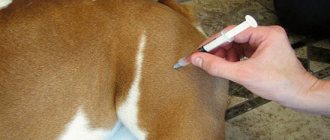The dog is breathing normally, respiratory rate is normal
The first and main indicator of an animal’s health is its breathing rate, which is important to monitor. On average, an adult dog takes up to 30 breaths per minute, while puppies breathe a little more often and can take up to 50 breaths per minute.
An important influence on a dog’s breathing is exerted by its age, breed, as well as its physiological state:
- A large breed animal breathes more slowly, and a small breed animal breathes more often;
- females breathe more often than males;
- breathing becomes more frequent during pregnancy and nursing puppies.
You can determine the number of breaths by the movement of the chest:
- small breed dogs take no more than 30 breaths per minute;
- medium breeds - no more than 25 breaths per minute;
- large breeds – no more than 20 breaths.
Types of shortness of breath in dogs
Cases when a dog has severe shortness of breath should alert the owner, because this indicates the presence of a number of symptomatic manifestations. First of all, when independently examining a dog and establishing the nature of inhalations and exhalations, it is necessary to have an understanding of such concepts as expiration and inspiration:
- Expiration is short inhalations and long exhalations. During such breathing, wheezing or wheezing is often observed. All this may indicate a narrowing of the bronchial region, which occurs in the presence of bronchitis or asthma.
- Inspiration is sudden short or heavy long breaths. This symptomatology in an animal may indicate the presence of swelling of the respiratory tract or the entry of a foreign object into it.
The severe condition of a pet during shortness of breath
The most severe condition of a dog is the mixed type of breathing, during which it is difficult for the pet to both inhale air and exhale it.
During this, a severe cough may occur, or the dog begins to wheeze.
Symptoms of shortness of breath
As a rule, breathing is disrupted in three parameters at once (frequency, depth and rhythm) - this is how the body signals a lack of oxygen.
Signs of respiratory failure:
- noticeable effort on inhalation or exhalation;
- the appearance of additional sounds (wheezing, whistling);
- open mouth breathing;
- excitement followed by depression;
- unusual posture (an anxious animal stretches its neck and spreads its front paws, but cannot lie down);
- paleness or cyanosis of the gums and lips.
Important!
You need to know that external respiration is closely related to the activity of the circulatory system: that is why failure of breathing always leads to increased work of the heart muscle.
Signs characteristic of shortness of breath
The main signs of developing shortness of breath in a dog are the following factors:
- shortness of breath in the dog appears in a calm state;
- with its mouth closed, the pet cannot take a breath;
- whistling sound and wheezing appear during breathing;
- the color of the mucous membranes changes to paler;
- The pet has a constant cough.
Important! When problems arise, the animal begins to look apathetic, its legs give way, or it strongly stretches its neck.
Symptoms of the disease
The pathology is manifested by frequent, jerky breaths with an open mouth. When shortness of breath is also observed:
- fainting and loss of consciousness;
- cyanosis of visible mucous membranes;
- cough;
- vomiting;
- wheezing, whistling when breathing.
Expert opinion
Kuzmenko Olga Olegovna
Information about the expert
Ask a Question
Cardiac dyspnea occurs when walking, while the dog often sits or lies down, tries to catch its breath, and coughs. The pet practically cannot run.
Causes of shortness of breath in dogs
The reasons for the development of shortness of breath in a dog can be different. Among the main ones are:
- Cardiogenic. This group includes all cardiovascular diseases that can provoke the development of shortness of breath. Even with the slightest physical exertion, the pet has breathing problems. If there are cardiogenic causes, the animal cannot run and always tries to sit or lie down.
- Respiratory. This includes receiving any injury or developing an infectious pathology, which contributes to the development of breathing problems.
- Pathologies of the central nervous system. This group includes malignant tumors, hemorrhages, injuries, etc., resulting in difficulty breathing.
Dog cough
Physiological causes of rapid breathing
Often, shortness of breath in a dog occurs due to physiological reasons due to the characteristics of the animal’s breed, for example, severe obesity or poor physical fitness.
Rapid breathing also occurs as a result of severe overheating of the animal. In this case, it must be immediately isolated in a cool place, but the owner must be nearby and stroke the pet in order to avoid a stressful situation.
On a note! Respiratory distress occurs in dogs that give birth, but it should last no more than 24 hours. If after childbirth breathing has not been restored, then you should immediately seek help from a veterinarian.
During a trip in a car, the animal’s breathing also quickens, because every move is stressful for him, but at the end of the trip, breathing is completely restored.
Causes
For ease of diagnosis, the causes of shortness of breath are divided into three volumetric blocks:
- respiratory;
- cardiogenic,
- pathologies of the central nervous system.
The first group includes diseases of internal organs and systems, disruptions of their functioning, various injuries, infections, as well as foreign objects entering the respiratory tract. Respiratory shortness of breath can be caused by diseases such as pleurisy, pneumonia, tumors in the respiratory tract, fracture, chest contusion, and fluid accumulation in the chest.
The second group includes cardiovascular problems and circulatory disorders. Cardiogenic shortness of breath is promoted by pulmonary edema, which develops against the background of weakening of the heart muscle. As a rule, the dog has a heart defect, chronic or acute heart failure, cardiomyopathy, and anemia.
Causes belonging to the third group: malignant and benign neoplasms of the brain, previous head injuries, electrical injuries, hematomas, metabolic disorders and, as a consequence, diabetes, as well as diseases of the genitourinary system and liver due to the presence of toxins in the blood. Also, shortness of breath can often be caused by severe stress, painful shock, high fever, and obesity.
Representatives of certain breeds are prone to shortness of breath due to the structure of their muzzle - pugs, bulldogs, Pekingese. A flattened nose and the position of the tissues of the soft palate prevent them from breathing fully, inhaling and exhaling air.
Such dogs snore and make a characteristic whistle constantly, even when sleeping. This creates additional stress on the respiratory system, so stress, fever, and inflammation are most often observed in these breeds, which can lead to serious complications, including death.
Sometimes shortness of breath is observed in dogs that have recently given birth and goes away within 24 hours, but if difficulty breathing lasts more than 24 hours and is accompanied by severe blood loss, loss of coordination, vomiting and hyperthermia, you should promptly call a veterinarian.
Whatever the cause of shortness of breath, if the animal exhibits secondary signs (cyanosis, fainting, severe coughing, spitting up blood, etc.), contacting a veterinary clinic should also be done immediately.
How can you determine the source of the problem?
To determine the source of the problem, it is imperative to do an ultrasound, x-ray, and donate blood and urine for analysis in order to help your pet in time and prevent the development of serious problems.
Important! It is imperative to consult a veterinarian about subsequent treatment.
Excess weight of the animal and postpartum shortness of breath are considered normal, but if this is accompanied by vomiting, fever and weakness, then it is worth undergoing a full examination. Postpartum shortness of breath may indicate a large loss of blood and, if left untreated, can be fatal for the pet.
Shortness of breath in a pet during obesity
Diagnosis of the disease
If there are clearly visible signs of fatigue and shortness of breath, the dog should undergo an ultrasound and x-ray examination, as well as urine and blood tests (including hormonal tests). In addition, a mandatory consultation with a veterinarian will be required, and, if necessary, an examination for the presence of small parasites with subsequent treatment.
If metabolic processes are disrupted, similar to the previous case, tests are immediately taken, an ultrasound scan is performed, and liver tests are also sent for examination. Obesity and postpartum shortness of breath, although considered completely acceptable, are often accompanied by fever, vomiting and poor coordination. The appearance of these signs in the postpartum period may be associated with large blood loss.
If postpartum shortness of breath is observed continuously over a number of days, you should urgently call a veterinarian at home. If you fail to act, these reasons can lead to death.
First aid for shortness of breath
If during regular walks the dog’s condition worsens in the form of tongue protruding or turning blue, then first aid must be provided immediately. First, you need to isolate your pet in a separate room to ensure complete rest. The room must be well ventilated, but without drafts.
Important! If a dog refuses to eat and does not drink water, then you should not force him to do this.
After isolating the animal, you should call a veterinarian. Before his arrival, all the owner can do is massage the pet’s chest, back and stomach. Upon arrival, the veterinarian will prescribe treatment, but in some cases, surgery under anesthesia or closed lung massage may be required.
Medical care for shortness of breath
Preventing shortness of breath in dogs
To prevent the development of a dangerous disease, it is necessary to carry out the following preventive measures:
- regularly get vaccinated against viral infections;
- in the summer, walk the dog in the early morning or evening to avoid overheating of the animal;
- Take your pet to the veterinarian once a year, even in the absence of negative symptoms;
- carry out deworming regularly (once every four months);
- Dogs with bronchial asthma should be regularly monitored by a veterinarian and owner.
Thus, the appearance of shortness of breath in a dog is a sign of some disease and requires immediate treatment, because in some cases it can be fatal for the pet. It is important to carry out diagnostics in order to stop the problem in time. It is not recommended to carry out treatment on your own, but you should wait for the arrival of an experienced veterinarian.
Prevention measures
For dogs with heart problems and pregnant bitches, it is advisable to organize a gentle regime at home. If the animal sleeps a lot during the day, this should not be prevented. You should never forcibly wake up your pet, even if the dog suddenly fell asleep, as it seemed to the owner, at the wrong time.
It is necessary to protect your pet from all infections and protect it from contact with street dogs. If she has chronic respiratory disorders, you should not arrange noisy games for the animal. Also, you should not take sick dogs hunting.
In order for the dog to always breathe well and have a healthy heart, the owner must pay great attention to the prevention of obesity. To do this, it is not necessary to put your pet on a strict diet. Sometimes it is enough to simply replace food from the owner’s table with special food and wean the animal from begging for tidbits. You should also completely exclude baked goods and sweets, sausages and other sausages from the animal’s diet.
To prevent obesity, you need to walk a lot with your animal. To avoid missing the onset of heart disease, older pets need regular electrocardiograms (for large breeds) or heart ultrasound (for small breeds). If the doctor has prescribed your pet some medications to improve cardiac activity, they must be taken as a course, and not occasionally.
Heavy breathing in a dog does not always indicate illness. On the contrary, most often this disorder is temporary, does not require treatment and goes away on its own. However, the owner must closely monitor the well-being of his pet and contact a veterinarian at the slightest deviation. Only in this case will the dog grow up healthy and live for many years
. Breathing is a serious issue, so a dog owner should understand that if there is even the slightest suspicion of respiratory distress, they should immediately take their dog to a veterinarian.
Attention, TODAY only!
An attentive owner notices any changes in the behavior of his dog. What to do if your dog is breathing frequently? What are the reasons for this phenomenon?











